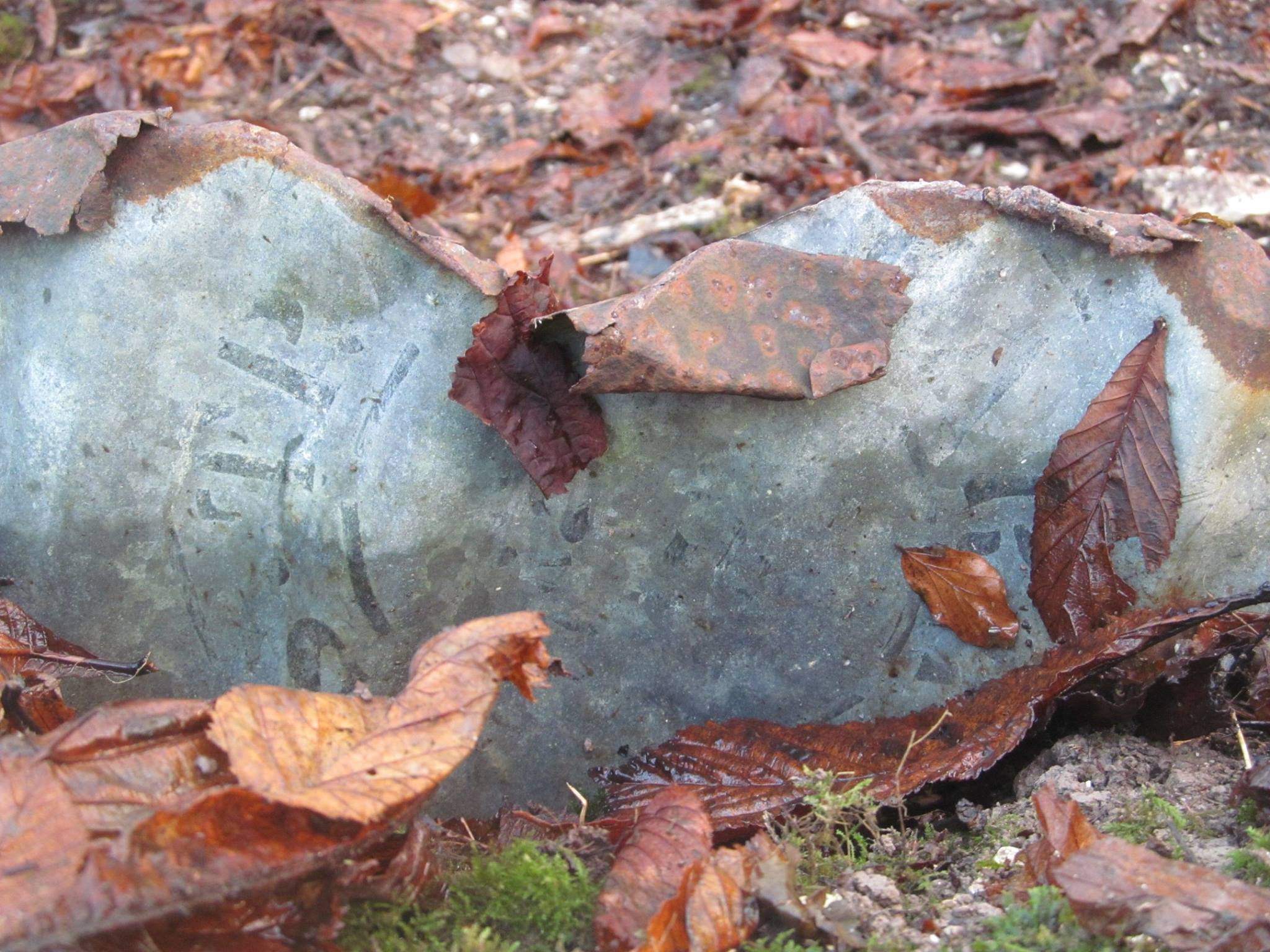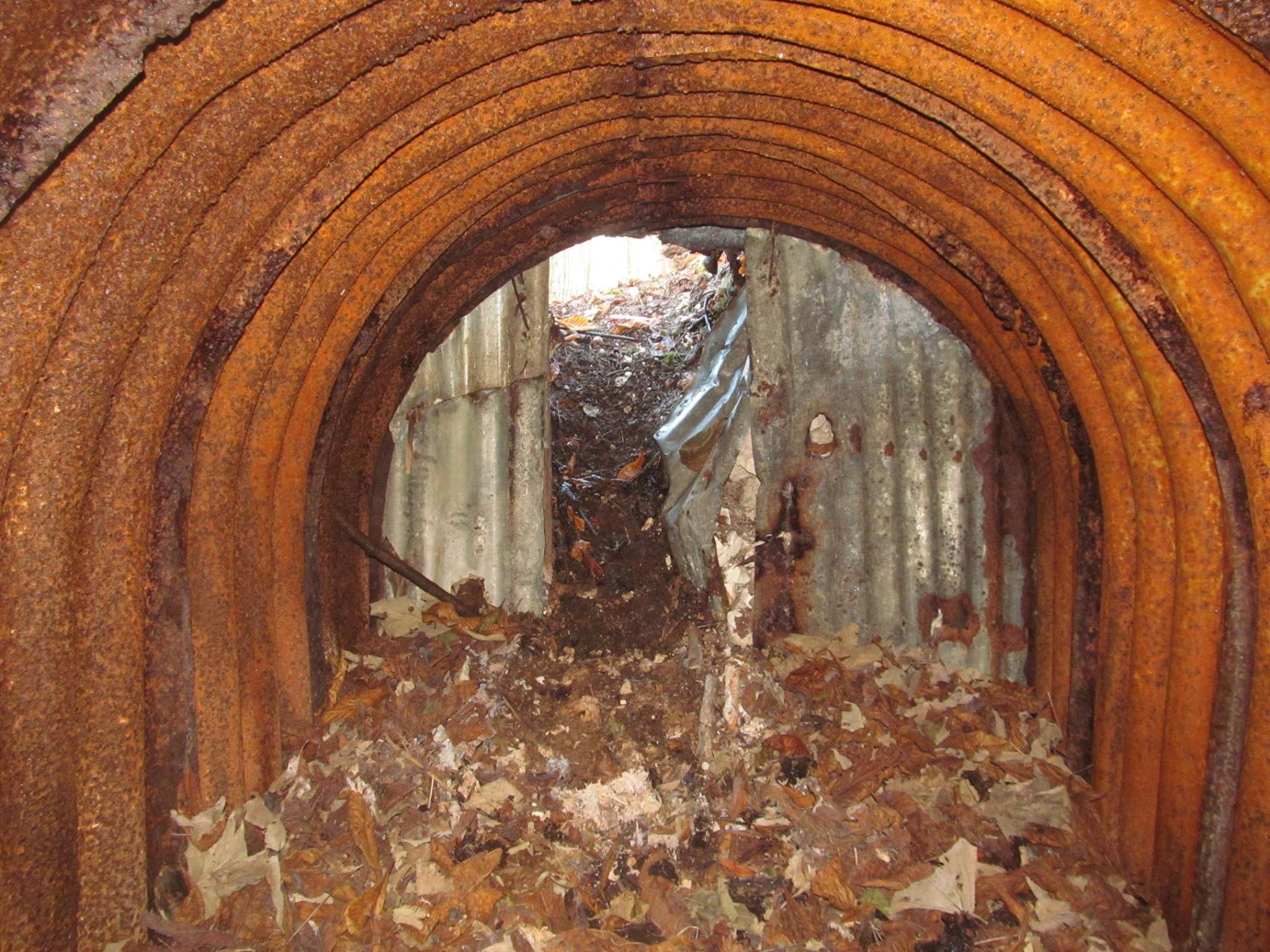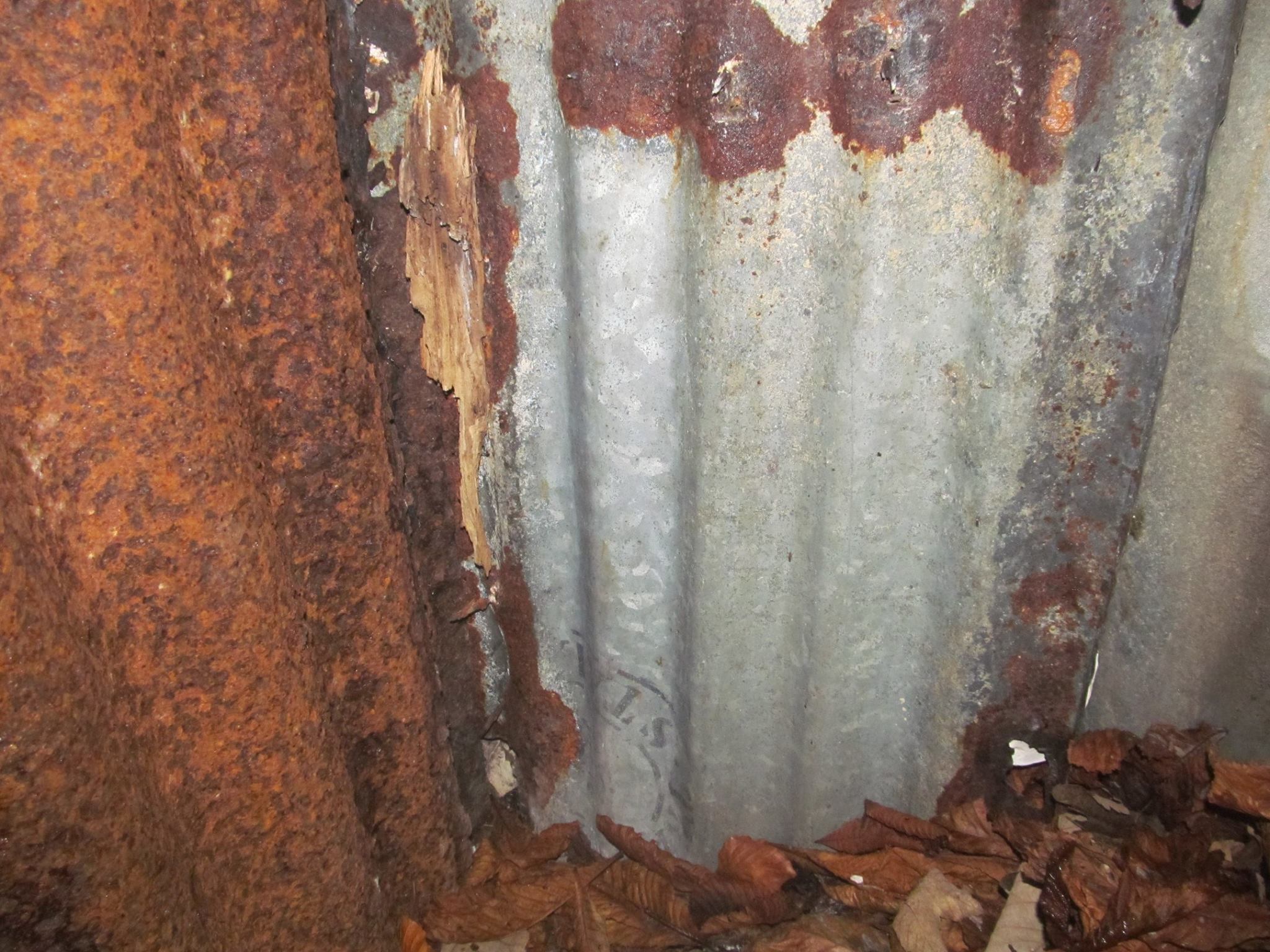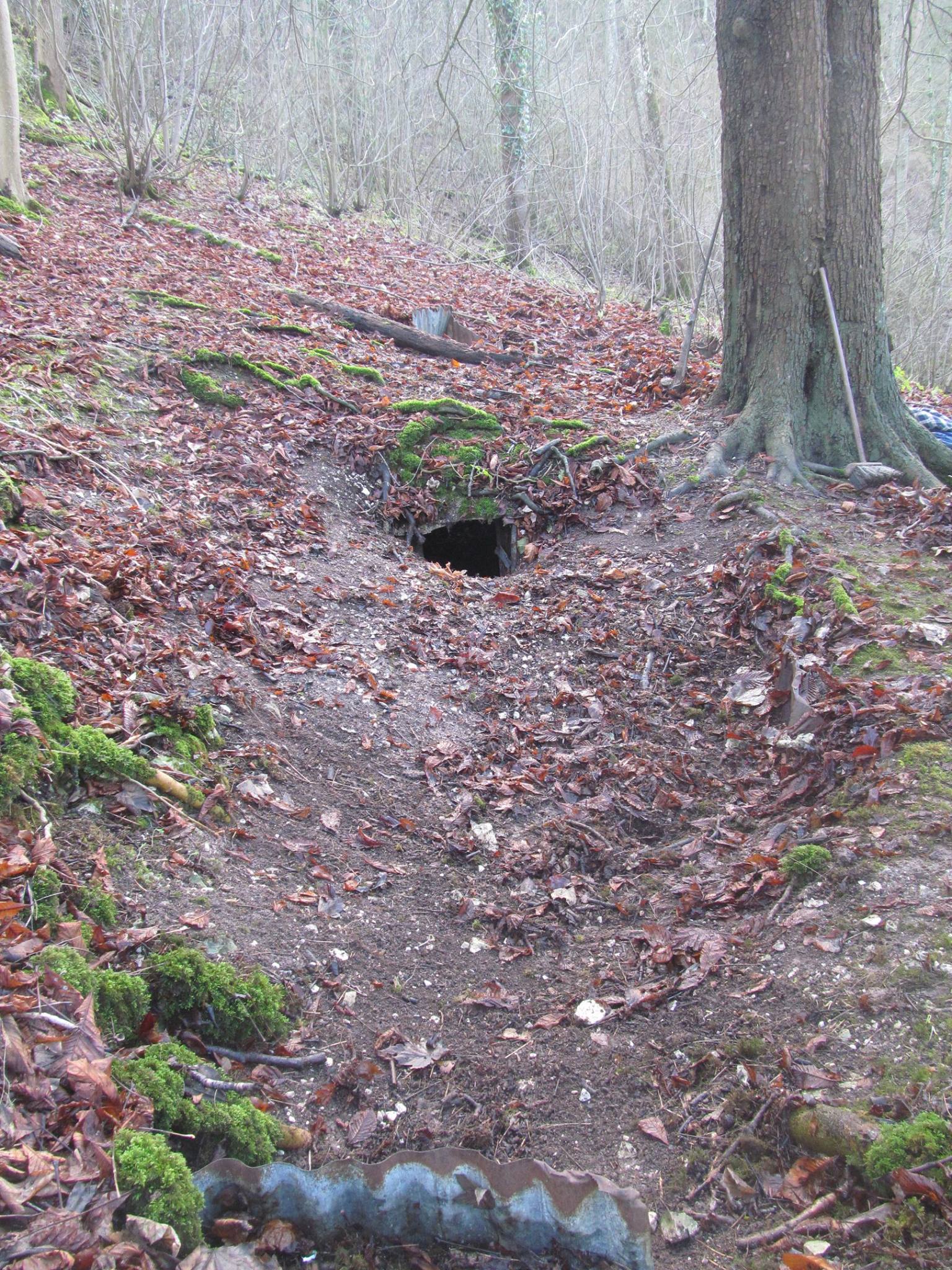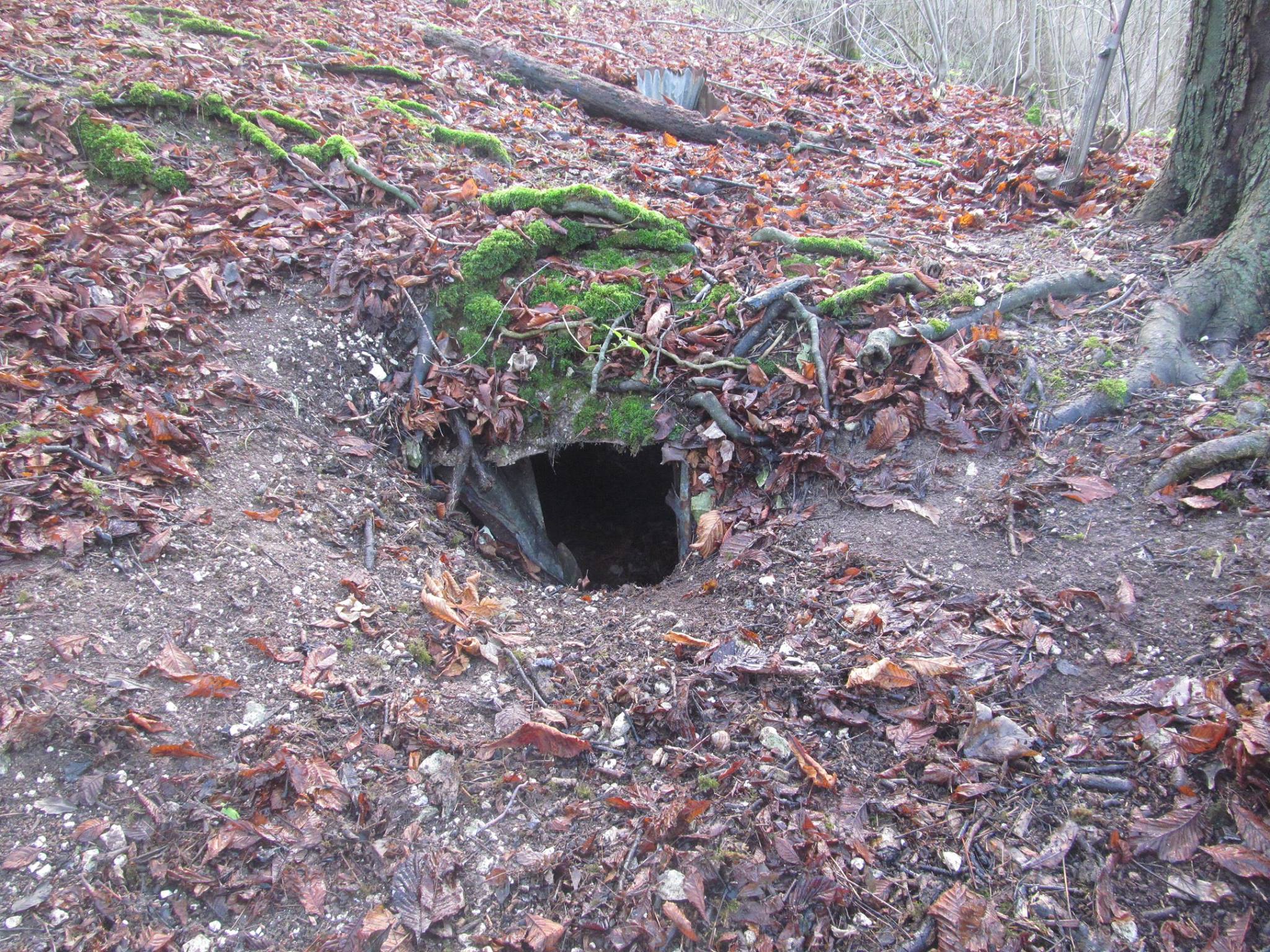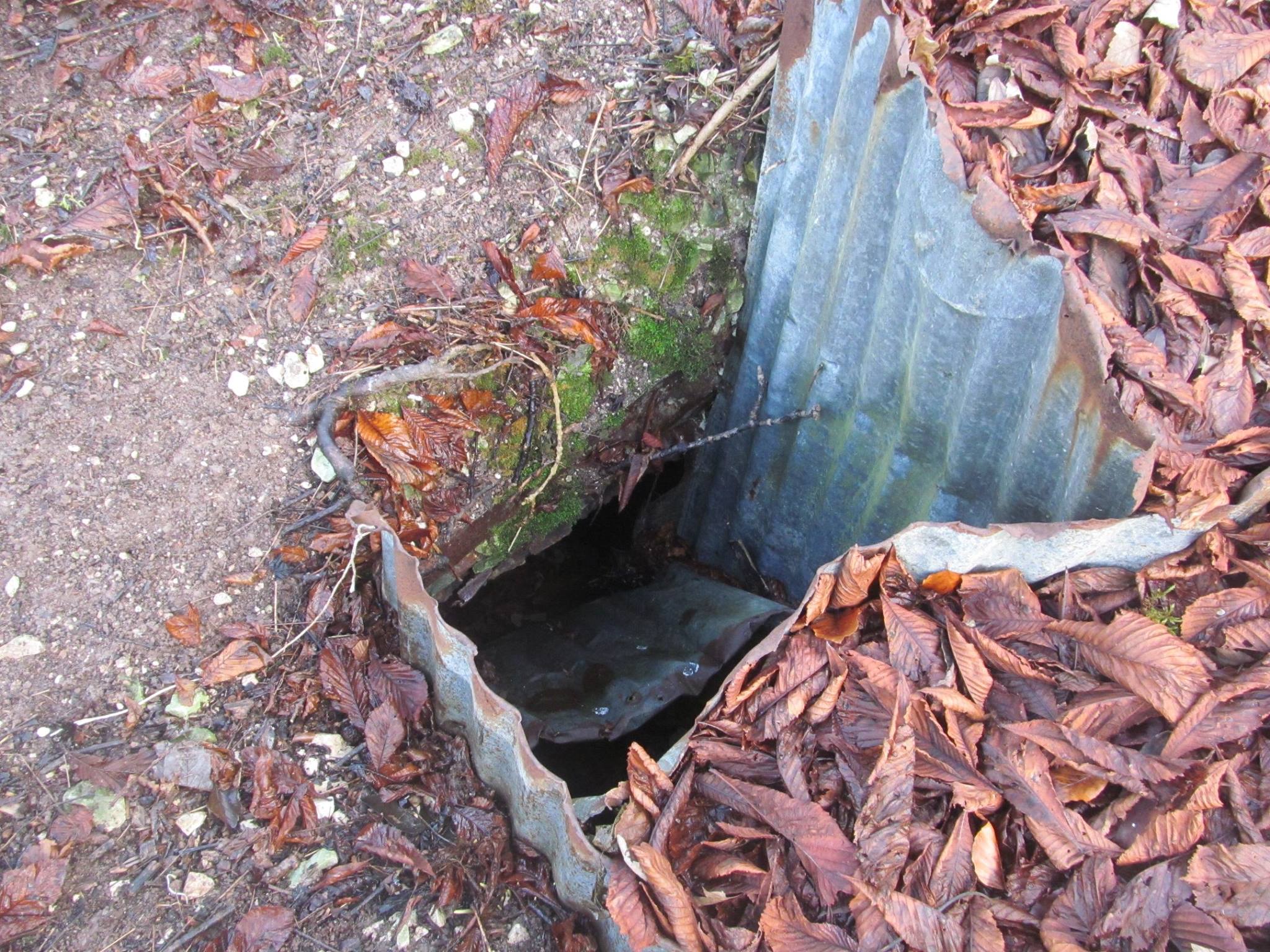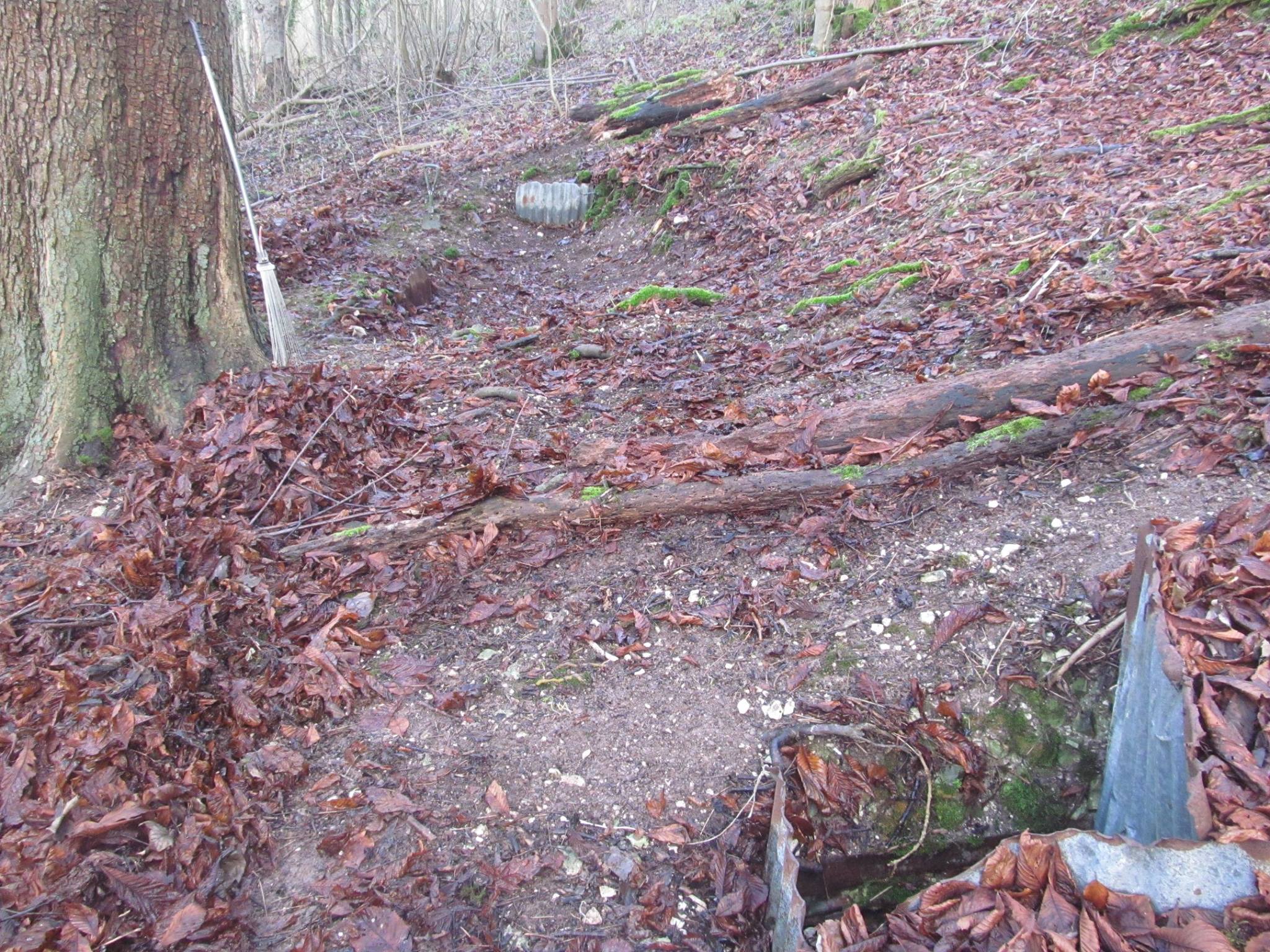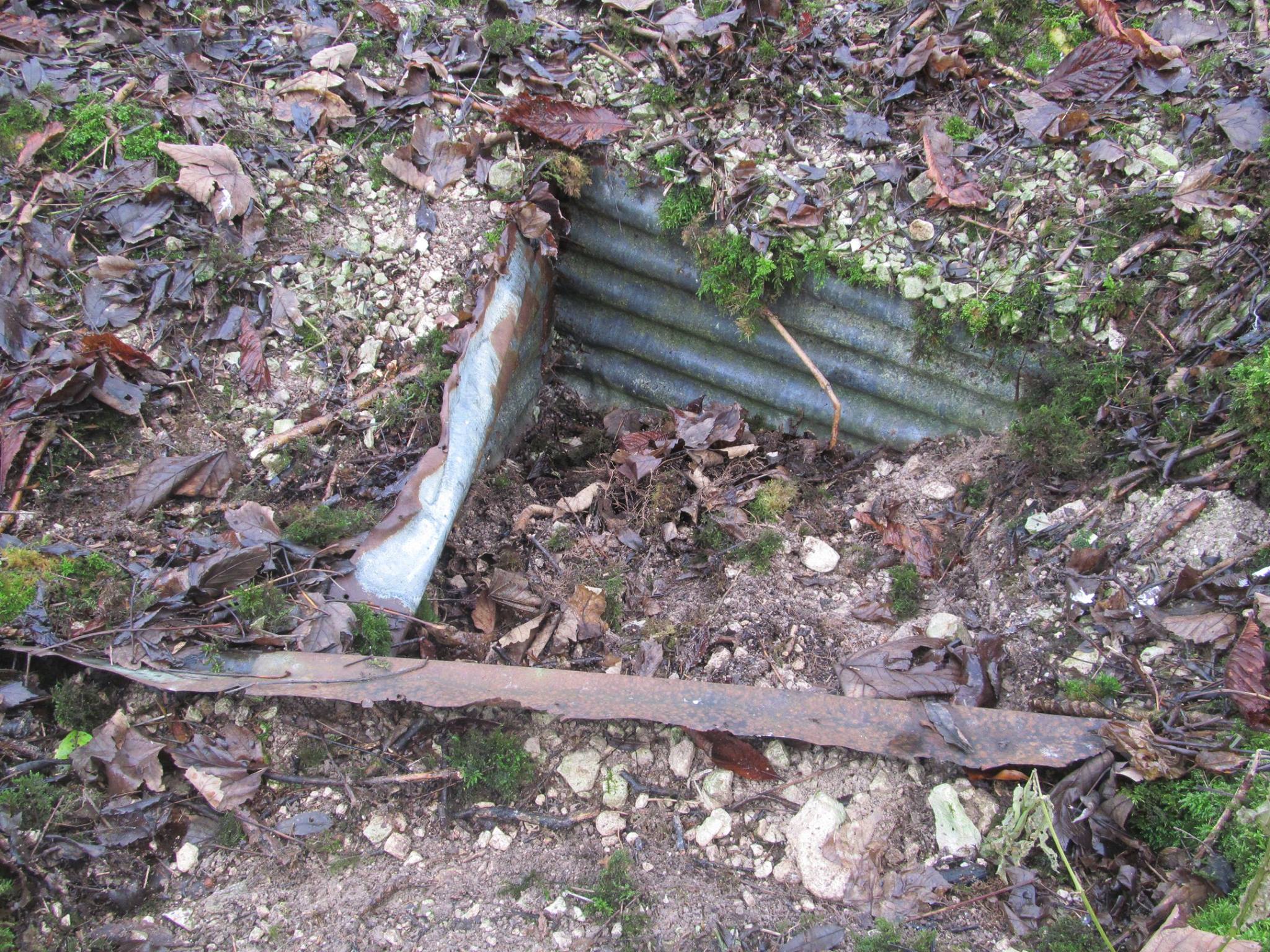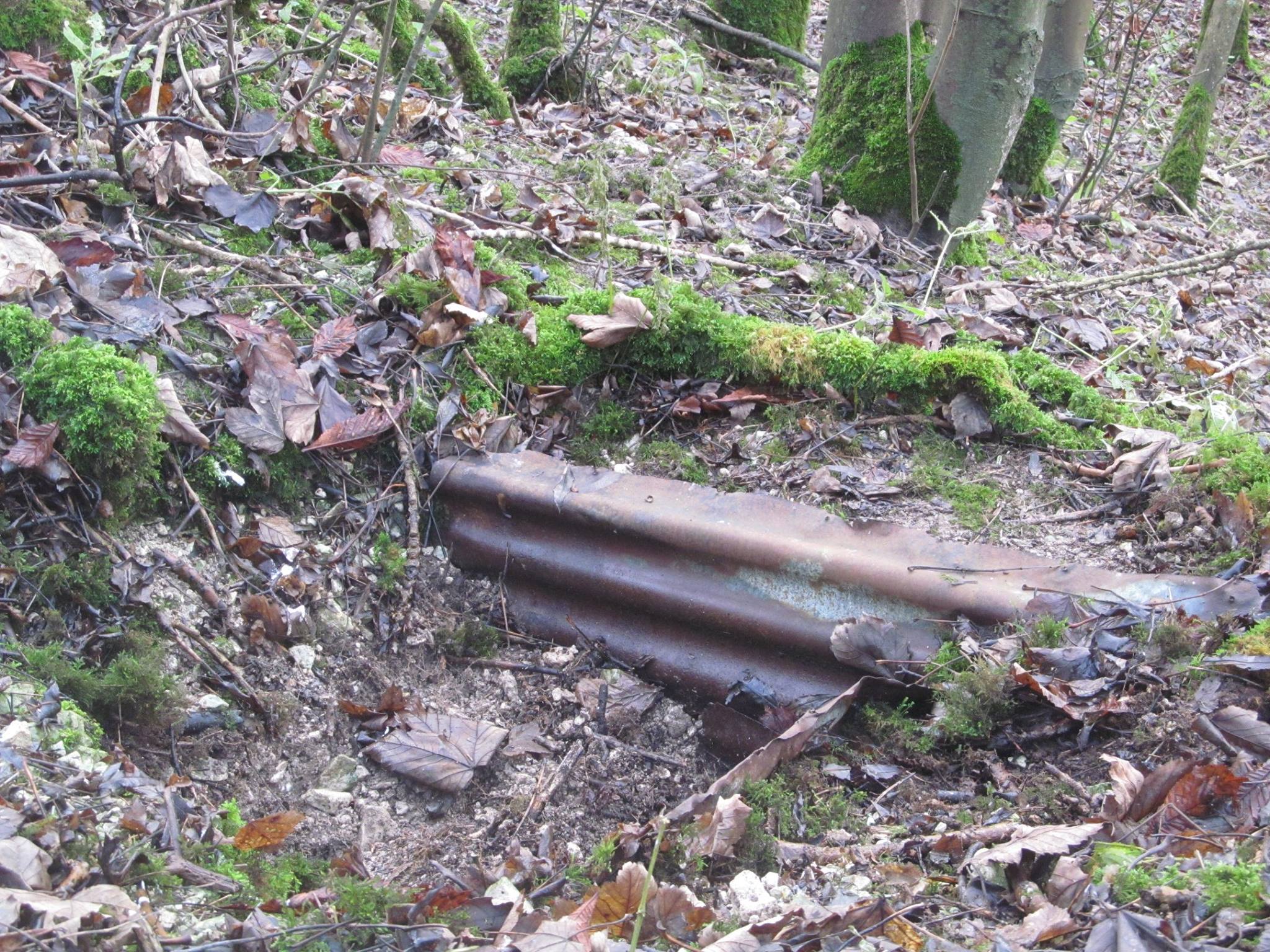Firle is located south of the A27 road four miles east of Lewes, Sussex.
| Name | Occupation | Posted from | Until |
|---|---|---|---|
| Sergeant William Arthur Webber | Market garden foreman |
31 May 1940 | 03 Dec 1944 |
| Private John Thomas Cornwall | Painter & decorator |
24 May 1940 | 03 Dec 1944 |
| Private Herbert John Henry Pilbeam | Farm labourer |
27 May 1940 | 03 Dec 1944 |
| Private Tom Smith | Market gardener |
23 Jun 1940 | 03 Dec 1944 |
The OB is positioned very close to a main footpath that connects the upper part of the Downs to the lower level of the Firle Plantation Wood. The spot chosen has a levelled off area with steep slopes above and below. Trees are positioned all around the local area.
The chalk spoil created from this excavation was spread under the trees in the lower part of the plantation.
The main chamber has collapsed and the only evidence is a depression in the ground and some corrugated sheeting marking the site of the entrance shaft. The Anderson shelter extension is accessible either by crawling in through the connecting tunnel between the extension and the main chamber or by descending the emergency escape shaft which is tight.
The entrance hatch was opened by lifting a small tree trunk which was attached to it. The earth on top of the hatch was kept in place by netting which had moss and leaves intertwined in it to disguise its existence.
The OB contained three bunks at one end with a stove. Food, ammunition and explosives took up most of the remaining area. Water was stored in a galvanised tank. An extension was later added to the main chamber in the form of an Anderson shelter along with an emergency exit.
Twenty yards north of the OB was a small underground store which contained extra food and ammunition. To the south there was an underground Observational Post, connected to the hideout via a direct telephone line. It only had enough room for one man inside and overlooked the main track through the upper part of the plantation.
Due to the discovery and ransacking by Canadian soldiers on several occasions in 1942 this OB was abandoned. The Patrol then shared the Bishopstone OB from August 1942.
Firle Patrol
Targets for the Patrol would have included the main A27 road between Polegate and Lewes and the railway line between Polegate and Glynde.
Patrol Leader Bill Webber and Tom Smith both recalled using the OB as part of their training and many nights they walked from Firle to Bishopstone to join their neighbouring Patrol in training exercises. He recalled the time the Patrol followed the River Cuckmere from its haven at Exceat all the way to Heathfield. They crossed the river at various points during the journey. On another occasion he took a high-ranking officer based at Coleshill, from their OB at Firle, over the Downs to Bishopstone using only a prismatic compass and the stars to guide them.
Bill Webber kept a diary of his Patrol's movements during their operational years. Although the entries are brief it gives a detailed account of their training, visits to Coleshill House and Tottington Manor, inter-Patrol competitions and interactions with neighbouring Patrols.
The diary contains 124 entries and is about 1200 words. Not every entry that appears in the diary is noted here as it would become repetitive. Only the most informative entries have been summarised, with additional details supplied by Bill Webber, who discussed the diary with the author.
The first entry was made on 5 October 1941 and mentions a rally at Northease Manor. At this event Captain John Gwynn mapped out the autumn and winter programme for the Patrols. He also gave his farewell speech on this day and introduced his successor Captain Bond.
The evening of 22 October 1941 saw the Patrol practicing in the FirIe area. An attack was also made on the Patrol's OB by Badger I. Badger I was the code name for the neighbouring Bishopstone Patrol. This exercise lasted five hours between 1800 and 2300 hours.
A combined Patrol operation was held on 29 October 1941, with both Firle and Bishopstone Patrols at full strength. This involved an attack on a Canadian guard hut at Bishopstone. It lasted six hours between 1900 and 0130 hours. At this point it is worth remembering that all the Auxiliers had to do their daytime jobs as well as these night training sessions which lasted for many hours at a time.
The weekend of 8-9 November 1941 was spent training at Tottington Manor. Lectures were given by Colonel Bill Beyts who came down from Coleshill House specifically for that weekend. Colonel Beyts was in charge of training at Coleshill.
On 29 November 1941 an inter-Patrol competition was held at Bishopstone. Competing were members of the Bishopstone, Cooksbridge, Ringmer and Abbot's Wood Patrols. The events included Mills bomb throwing, pistol, rifle and Thompson sub-machine gun target shooting and a night patrol efficiency test. Cooksbridge Patrol came first with 84 points, Bishopstone second with 81 points, Abbot's Wood third with 55 points and Ringmer last with 43 points.
On 10 December 1941 FirIe and Bishopstone Patrols started practising map reading.
The Sussex final of the inter-Patrol competitions was held at Tottington Manor, on the weekend of the 20-21 December 1941. This was won by Icklesham patrol who then went on to represent Sussex in the second competition final at Coleshill House.
6 January 1942 saw the FirIe Patrol engaged in an attack on tanks in Stanmer Park, just outside Brighton. This took place between 1900 and 0030 hours, the Firle Patrol being successful in their task.
Saturday 14 March 1942, saw the Patrol practice their drill for action in the event of an invasion by the Germans. They had to get to their OB with all their kit. This started at 0700 hours Saturday morning and finished 1130 hours on Sunday.
On 26 March 1942, a Patrol Leaders meeting was held at Allington Farm, East Chiltington. This was where the Cooksbridge Patrol Leader, Frank Martin lived. After the meeting they all visited the Cooksbridge Patrol's OB.
Captain Bond gave a lecture at Bishopstone on 15 April 1942 about using and concealing knives. By 23 April this was being put into practice. The Patrol attacked a sentry with the object of killing him silently with a knife. This operation lasted from 2000 to 2200 hours.
30 April 1942 saw another Patrol Leaders meeting at Allington Farm. The men were issued with the silenced .22 rifles with telescopic sights, for the first time at this meeting. They were also given a new pass-word. Bill Webber could not remember what this was but recalled that such phrases as 'Rule Britannia', 'South Down' or 'Sussex Weald' were used at any given time.
On 25 June 1942 a Patrol Leaders meeting was held at Offham. They learnt that Captain Bond was leaving to take up a new appointment. They also heard details of another inter-Patrol competition that was to be held on 12 July.
On the days 28 June, 2 July and 5 July, 1942 the Patrol trained for the forthcoming competition. The competition was held on the 12 July at Mary's Farm, Falmer. The Cooksbridge Patrol won. Bishopstone and FirIe finished third after leading. They lost valuable points on the last event called a 'relay'. This involved each man running at a target, while firing a Sten gun at the same time. Out of a possible 40 points they only gained 10. This put them into third place. After the competition they were introduced to Captain Bond's replacement Captain Benson.
On 31 July 1942 there was a Patrol Leaders meeting at Offham. This was the first to be chaired by Captain Benson.
On 20 September 1942 a Patrol meeting was held to work out the coming winter programme. Map reading and patrol work took place in Firle Park.
A Patrol Leaders meeting was held at Offham on 25 September 1942 and the next months programme arranged.
On 30 September 1942 Captain Benson visited the Bishopstone Patrol. He was very impressed with the OP and OB. While Bishopstone Patrol Leader Lionel Willett showed the Captain around, the rest of the Firle Patrol, led by Bill Webber, stalked and waylaid them
12 October 1942 saw both the Bishopstone and Firle Patrols completing an explosives practical. Both used a standard charge (80z of gelignite) and both charges went off successfully.
Bishopstone Patrol was visited on 29 October 1942 by Colonel F W R Douglas, Commander from Coleshill House. The Commander later gave an address to Patrol Leaders at Hailsham.
On 22 November 1942 a meeting of Patrol Leaders from all over Sussex was held at Tottington Manor. Captain Benson laid down a training programme for greater efficiency and to forestall any staleness that might be affecting the Patrols.
On 1 December 1942 the Firle Patrol had a lecture on the prismatic compass at Bishopstone. After this lecture much more map and compass work was undertaken.
The Patrol were map reading around the Chailey and Burgess Hill area on 13 December 1942. These were strange surroundings which made the exercise much more difficult.
The Patrol practised more compass work with the Scout Section on 17 December 1942 during a night time operation in Hailsham.
On 29 December 1942 Bill Webber and Bishopstone Auxilier John Willett (Lionel Willet's son) attempted to cross the River Ouse in a rubber dinghy. Both men were thrown into the water when the craft suddenly turned over. They were both in full kit and the water was very cold. The exercise took place between 1830 and 2100 hours.
A weekend training course took place at Coleshill House from 8 January to 10 January 1943. This was the second time Bill Webber had been to Coleshill. The first time was in 1940. He was accompanied by Tom Smith, Jack Clark and Charlie Woolmer. Tom Smith and Bill Webber took part in a night operation around Coleshill House. Bill Webber attained full marks for Mills bomb throwing, one of his favourite events.
The weekend 16-17 January 1943 saw a Patrol Leaders' course at Tottington Manor. This was a very intensive course which included such items as the right and wrong way to stalk, behaviour in the OB, firing of the Sten gun, revolver and rifle, lectures on the course of the War, first-aid, care of arms, and giving orders.
On 31 January 1943 the Firle Patrol visited the Rodmell Patrol to see their OB and OP.
11 February 1943 saw the Patrol crossing the River Ouse at Durham Farm near Tarring Neville and walking down to Brookside Farm just outside of Piddinghoe. They returned the same way. The Patrol used a rubber dinghy and both river crossings were successful. This exercise took place between 1900 and 2300 hours.
On 16 February 1943 there was a Patrol Leaders meeting at Allington Farm with Captain Benson as chairman. They all heard that Lieutenant Ashby and the Scouts were leaving the Auxiliary Units to return to their regiments. The reason given for this was that they had to prepare and be available for the Normandy landings. Soon after this the Auxiliary Units were asked for volunteers to be parachuted into France as a pre-invasion plan. This would entail two weeks of intensive parachute training which the Auxiliary Units lacked. Both Bill Webber and Tom Smith volunteered from the Firle Patrol.
Entries in the diary are few and far between after this date. This was due to the threat of German invasion passing and training becoming more relaxed. Even so the Firle Patrol continued to train as a Patrol until the stand down was ordered on 18 November 1944. The last entry in the diary is 9 January 1944 and mentions a Patrol course at Tottington Manor.
The Firle Patrol was the smallest patrol in Sussex, having only four members.
All the men were originally in the Home Guard until Bill Webber was approached by Captain Gwynne with a view to his joining the Auxiliary Units and forming the Firle Patrol.
On 18 January 1942 Bill Webber visited the Patrol's OB and found that the Canadian soldiers based at FirIe Place had been digging slit trenches within the FirIe Plantation.
They had found the OB entrance and forced their way in. It was not until 8 February that he found the Patrol's gallon bottle of rum was missing. On 5 March a Court of Inquiry was held on this matter. No blame was attached to Bill Webber and a verdict was made that a person or persons unknown had taken it.
It was discovered on 20 May 1942 that the entrance to the Patrol's OB had been forced open again and the operational rations ransacked. A Court of Inquiry was held at Bishopstone on 12 June about the loss of the ration packs. The outcome was again that a person or persons unknown had taken them.
31 August 1942 saw the FirIe Patrol moving their stores from their OB to the Bishopstone Patrol's OB. This was because the Canadian soldiers had broken into it yet again. Thereafter FirIe shared Bishopstone's OB and their own hideout was abandoned.
TNA reference WO199/3391
Hancock data held at B.R.A
'The Secret Sussex Resistance' by Stewart Angell
Stewart Angell's personal interview with former patrol members Bill Webber and Tom Smith and Bill Webber's diary.
Ed Tyhurst for 2017 images









